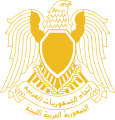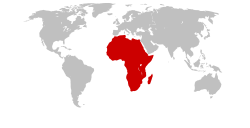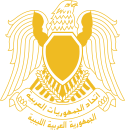Hoheitszeichen Libyens
Ein einheitliches Hoheitszeichen für Libyen existiert zurzeit nicht. Die staatlichen Organe verwenden jeweils eigene Embleme.
Geschichte
Das Wappen der Großen Sozialistischen Libysch-Arabischen Volks-Dschamahirija wurde 1977, mit dem Austritt aus der Föderation Arabischer Republiken, angenommen. Es zeigte anstelle des zuvor verwendeten Adler Saladins den Koreischiten-Falken – im Gegensatz zum ägyptischen oder syrischen Wappenfalken blickte der libysche Falke fortan jedoch in die entgegengesetzte Richtung. Das Grün des Schildes symbolisierte wie die Flagge Libyens den Islam und das so genannte „Grüne Buch“ Gaddafis mit den Grundsätzen der libyschen Revolution. Der Text auf dem goldenen Band bedeutete „Sozialistische Libysch-Arabische Volks-Dschamahirija“.
Das Siegel des Nationalen Übergangsrates fungierte von April 2011 bis zu dessen Auflösung im August 2012 als Hoheitszeichen Libyens. Es zeigte einen Halbmond und einen Stern in den Farben der Flagge Libyens (rot, schwarz und grün) sowie am Rand die arabischen und englischen Inschriften المجلس الوطني الانتقالي / al-maǧlis al-waṭanī al-intiqālī / ‚nationaler Übergangsrat‘, Transitional National Council sowie ليبيا / Lībiyā / ‚Libyen‘ und Libya.
Aktuelle Hoheitszeichen
- Siegel der in Tripolis herrschenden Regierung der nationalen Einheit
- Wappen, wie es die Gegenregierung in Tobruk bzw. deren Armeechef Chalifa Haftar verwendet
Historische Hoheitszeichen
- Osmanisches Tripolitanien
- Italienisch-Libyen 1940–1943
- Königreich Libyen 1951–1969
- Libysch-Arabische Republik 1970–1972
- Libyen in der Föderation Arabischer Republiken 1972–1977
- Frühe Version des Siegels des Nationalen Übergangsrates, März bis April 2011
- Siegels des Nationalen Übergangsrates, April 2011 bis August 2012
- Halbmond auf 2013 hergestellten Reisepässen Libyens
Auf dieser Seite verwendete Medien
Coat of arms of Libya ca. 1969-1971 -- standard pan-Arab "Eagle of Saladin" with shield of vertical tricolor of the then national flag, holding a scroll with the words الجمهورية العربية الليبية
(al-Jumhuriya al-`Arabiya al-Libiya or "Libyan Arab Republic").Autor/Urheber: Пакко, Lizenz: CC BY-SA 3.0
Emblem of the Kingdom of Libya, known as the "Crown of Libya", after a design used during 1952-1969.
The constitution of the Kingdom of Libya of 1952 in article 7 describes the flag, but not the emblem. No official description is available at present (due to the restrictions placed on government archives since the military coup of 1969), and the design is reconstructed from many variants in shape and color schemes. The 24dec1951.com website conducted research into the design as represented in official government sources of 1952-1969, and describes the emblem as follows:
- Top Crown adorned with a white Crescent and five-pointed star at its summit, at which five visible side frames originating from a ring at the base converge. The star studded base and frame contain a velvet black head cover like object.
- The Top Crown is supported at its base by two beautiful plantar designs; in the form of three intertwined C and S scroll shapes.
- Two massive “Shoulder” frames contain the body of the crown from the right and left [...]. Each side is a complex formation of intertwined branches in the shape of an S Curve, which is essentially two back-to-back C scrolls; the larger one of which terminates in a large beautiful spiral at the top. [...]
- The background color of the large interior below the Top Crown can be white or transparent, although this is not evident in the picture of the Libyan pound. The background color of the center region surrounding the large white Crescent and Star is black as in the center stripe of the Libyan flag.
- A white ring with thin black borders, surrounds the center large white Crescent and Star.
- Nine five-pointed white stars surround the center ring.
- Large white crescent.
- Five pointed star located well above the perimeter of the crescent. This differs from the flag, which places the star at the extremities of the crescent.
- A Center Crown, seated above the ring containing the Crescent and Star. Its design is identical to the Top Crown, except for being smaller in size.
- Plantar/ floral ornamentation similar to #2 above, providing variation and connectivity to the base.
- At the base, an elegant design that resembles a document scroll with a ring tie at its center. It is noted that the color scheme of the crown is most likely white for the stars and crescents, black and white (or transparent) for spaces, and gold for the crowns and frames. [...]
Autor/Urheber: Rayan54, Lizenz: CC BY-SA 4.0
Lesser coat of arms of Ottoman Tripolitania, according to : http://hubert-herald.nl/INHOUD.htm
Autor/Urheber: Tsange, Lizenz: CC BY-SA 3.0
Coat of Arms of Libya within the Federation of Arab Republics
Star and crescent gold color placed on Libyan passports
Seal of the Government of National Unity of Libya
Libyan Coat of arms as used by the Tobruk government and its Field Marshal Khalifa Haftar - as seen here (Reuters)
The first seal of Libya's National Transitional Council, used March-April 2011



















